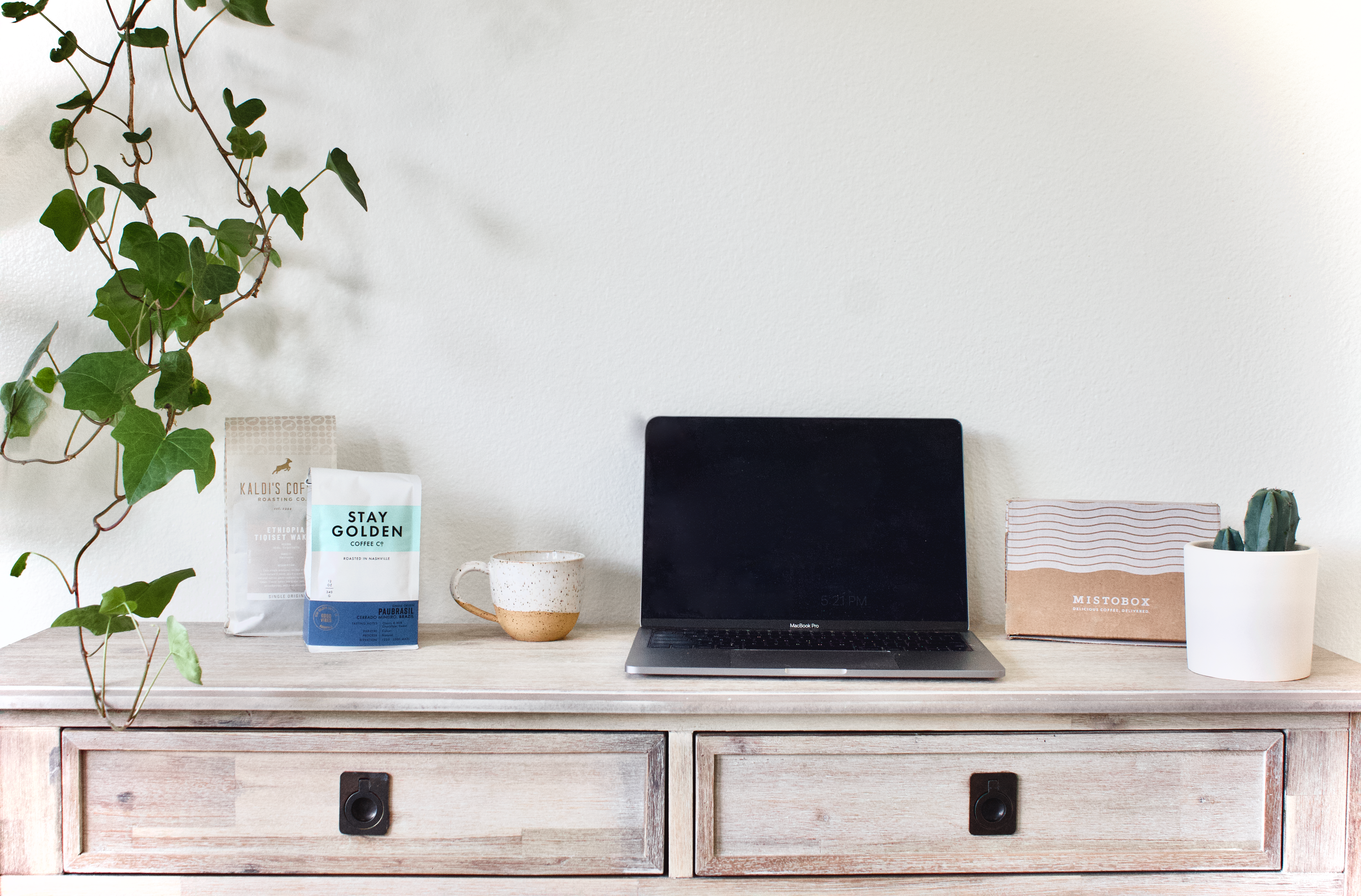MistoBox made the decision 6 years ago to transition to a completely distributed team. In that time we’ve run our company with employees living in more than 5 states, and at times traveling abroad (I myself have been in 18 countries in the last year alone). We’ve learned a lot about how to stay connected to each other, project-manage, and increase productivity with a team that only has the option to virtually communicate. In these trying times where many are working from home for the first time and with likely little notice or preparation, we wanted to compile our insights and experience to help people making this change abruptly. Here is what you and your teams need to know your first days working from home:
Expectations and Processes
The first key is to set clear, specific, and obtainable expectations for what each person is responsible for. When working from home for the first time there should be no ambiguity about who is doing what, when, how, and with whom. Accountability needs to increase initially, not because your workers can’t be trusted, but because clear expectations will keep your ship moving and prevent waste.
Other expectation-setting questions to answer immediately:
- What are everyone’s working hours Is there a set lunch hour? Can employees start and finish earlier since they are not commuting? Questions like these might be taken for granted while in a physical office, but need to be clearly answered when your workforce is distributed
- How do people need to be available? You’ll find that there are a number of ways people will try to get ahold of you if there’s an immediate need while working from home- text message, Slack, Asana, email, Gchat, etc. Being clear about which channel your team should use and when will help avoid missing messages and encourage faster responses. We have a Communication Best Practices Guide internally that outlines exactly when each channel should be used. It may seem like overkill, but it’s saved our team hours of work over the years.
- Where are people able to work from? In the age of COVID-19, most people will be working from home rather than cafes or co-working spaces, but many people also have the opportunity to travel home and spend time or take care of a family member who may be out of state. Are employees able to travel and work from a family home? Be clear about what working from home and social distancing means to your organization.
- What are your tech needs? Do your workers need a VPN (virtual private network) or some sort of encryption software? VPN’s come in handy if you’ll be working on unsecured networks (think free Wifi at Starbucks), as they can protect you from hackers. While most people will likely be working from home at this time on secure, password-protected networks, if your organization handles sensitive data or personal information (think healthcare, banking, or insurance) you’ll want to consider if encryption software is necessary or if your employees need new malware upgrades to keep your customer’s information safe.
Our Processes for working remotely
Weekly Hangouts: Every week, the entire team meets via Google Hangout. We each take turns discussing what we accomplished the previous week, roadblocks we encountered, and what we’re working on for next week. We also answer the infamous Question of the Week where you can learn A LOT about your coworkers. This year alone we’ve learned that Tyler’s guilty pleasure movie is Twilight, Connor’s favorite plant is grass and why (who loves grass?) and what the most embarrassing moment of Bailey’s life was (we will not share here). Our Hangouts are a great way to keep everyone accountable, motivated, in-sync, and more importantly, they’re really important to building our bonds as a team. In times of social isolation, we use this “facetime” as a means to connect with each other.
Weekly 1-on-1s: We in no way encourage having meetings for the sake of having a meeting, but having regular touch bases between managers and individual employees weekly to discuss work and results is incredibly helpful. Not just for teams new to remote work, but for our team who has a great deal of experience with it. In the weekly call with Connor, MistoBox’s Cofounder, I make an agenda and run through the list of all of the things that I might have updated him on or asked him a question on during the week had he had an office I could stop by. These regular touch bases allow us to stay on top of what we need from each other. He can understand what I’m working on and need assistance with, and we have frequent conversations about performance, not once a year or quarterly- but every week.
Fun Slack Channels: Many of you are going to feel isolated and if you live by yourself and are an extrovert, this is going to be an especially tough time. Something that has helped us are some fun, non-work related slack channels like #Random, which is a slew of interesting articles and fun internet memes, and #Coffee-talk where we all talk about one of our favorite things at length.
Establish your own routine
As you start working from home for the first time, look at this as an opportunity to evaluate and decide what makes you most productive and helps you get into a workflow. Many of us who spend our careers in an office adapt to that environment, but in remote working scenarios, you have the opportunity to adapt your environment to meet your needs. Here is a hotlist of our team’s advice on how to establish a routine and productive work schedule at home:
- Create a morning routine that eases you into work. Don’t just wake up and open your laptop in bed.
- Make your bed when you wake up and don’t get back into it.
- Get dressed. You don’t have to go for full business casual to sit on video calls all day but it’s an important mental indicator that you are about to get things done. Working in something you slept in blurs the lines. Find a “home office” uniform that’s comfortable, will work for your video meetings, and makes you feel powerful.
- Figure out when you are most productive and go hard during that time. I have unbelievable productivity and concentration from 7:30 AM to 10:30 AM. I avoid all distractions during this time, by turning off non-emergency notifications and avoiding scheduling meetings at that time. In those 3 hours, I get 5 hours of solid work done. When do you hit your stride and can you minimize distractions at that time?
- Setting work hours helps reduce distractions, meet expectations, and avoid working 16 hours a day. When working from home the line between work and personal life gets muddled. Do your best to set boundaries between the 2 so you can work smart during the day and relax at night without feeling like you’re still at the office.
- Be intentional with what it is you are doing. Set daily goals and tasks to complete. Tasks that require more focus and brain power-allocate to your most productive time of day.
- Coffee, and lots of it!
Create a productive workspace
- If possible, designate a working space that is only for work. We’re looking to create a physical boundary between work and other life. Try to make a place where only work happens and you “commute” to.
- Seek an “alert comfort area.” A place where you are comfortable, but is not one of your precious relaxation zones like a couch or bed. Neither of these places will give you the proper posture while working to breathe deeply, so you’ll notice yourself getting more tired.
- Control the elements. Now that you have thought about what helps your productivity seek a place that balances your needs like sunlight, temperature, and noise.
- Talk to partners, housemates, and/ or children about expectations and needs. If you are sharing the space establish a schedule so that your whole household understands this change. When 2 people are working from a one-bedroom apartment things can get tense, so if possible see if one person’s calls can be moved to the morning, and the other’s to the afternoon. Noise-canceling headphones will go a long way as well.
- Be aware of what’s behind you on your video calls. Art that may be inspiring to you, maybe offensive to someone else. You may not notice a person walking behind you on a call, but it could be distracting to the person you’re speaking with, or an invasion of privacy for people you’re sharing the physical space with.
- Think through what you need. If you are used to having coffee, La Croix, snacks, or anything else at your office- order these things online and make sure you’re fully stocked. (DOn’t forget filters!) The last thing you want is a snack attack in the afternoon and nothing in the house to eat.
Our Tools for working remotely
Slack: We use a messaging app called Slack to communicate. We can fire off direct messages to anyone on the team or chat in channels, which are basically chat rooms around specific topics. Our channel topics range from very practical like #customer-service where we discuss customer issues to the less practical but arguably more important like #making-a-murderer where we followed the show and discussed our theories.
Google Docs: Google docs allows us to work collaboratively on documents and to sync all of our files in one place.
Zapier: Zapier allows us to automate many of our processes. They’re also an awesome remote team. They share a lot of really valuable information on operating a remote team and have helped shape the way we run our company.
Asana: Asana is our task management tool where we can plan all of our projects, distribute the tasks to anyone on the team, and all stay in the loop on progress.
Krisp: This app allows background noise to be filtered out while taking calls. If you’re working from a busy cafe or from home with kids and animals running around this app will be a lifesaver.

Other Resources for working remotely
We don’t have all the answers and are still learning every day. Here is a list of resources we frequently use when we have questions on working from home best practices:
- Remote work emergency plan: What to do (and where to start)
- How to Work From Home for the First Time
- Does Your Company Have a Long-Term Plan for Remote Work?
- Remote Meetings 101: Everything You Need to Know
- Sharing our Remote first processes, tools and guidelines for fellow corona-dodgers
- Why Slack works when you work from home
- How to Manage a Remote Team



